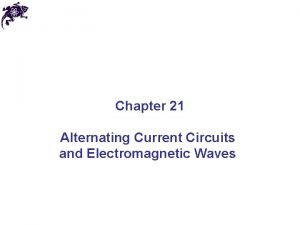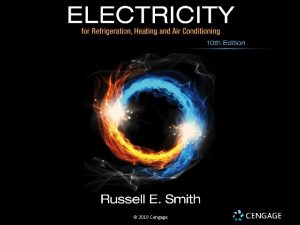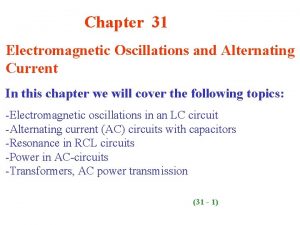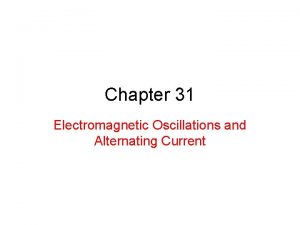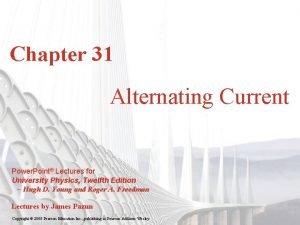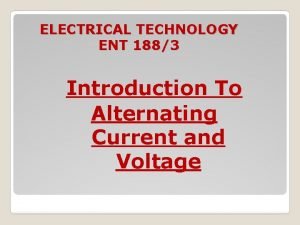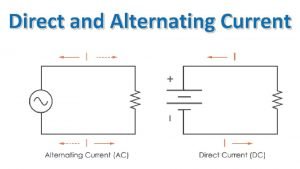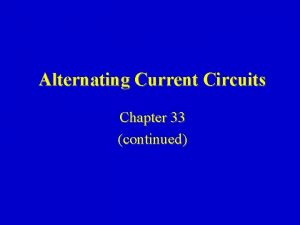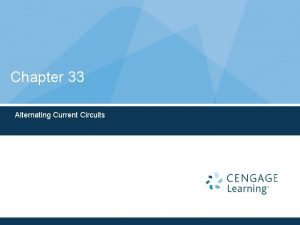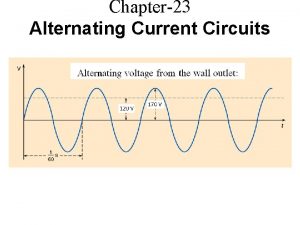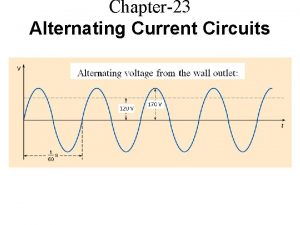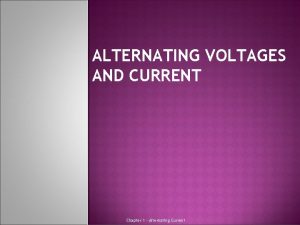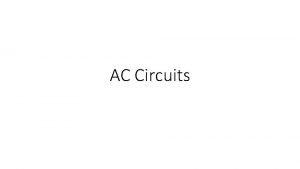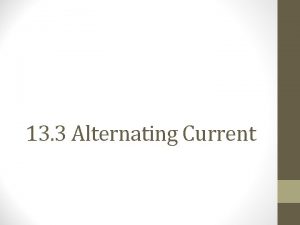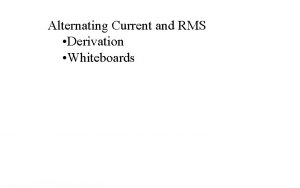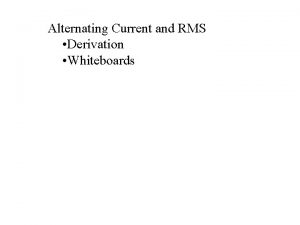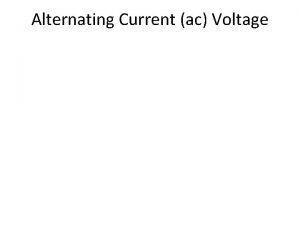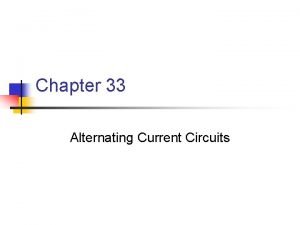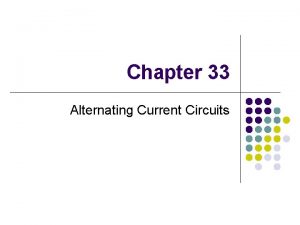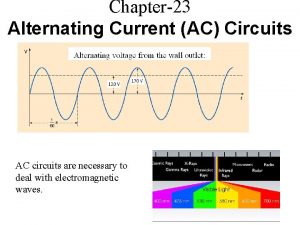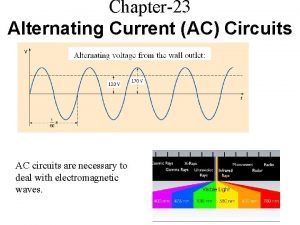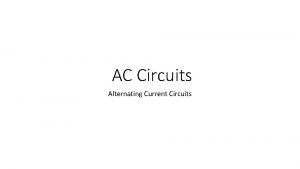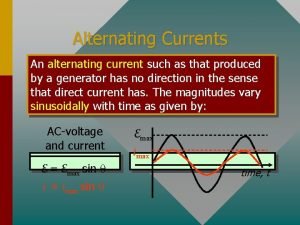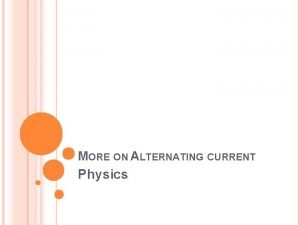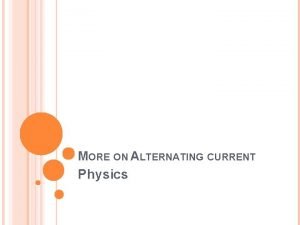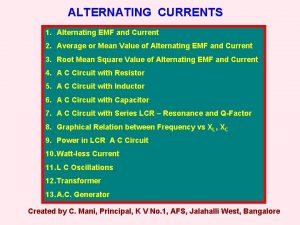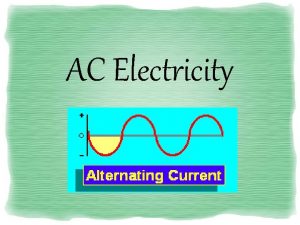Alternating Current Circuits Chapter 33 continued Phasor Diagrams


























- Slides: 26

Alternating Current Circuits Chapter 33 (continued)

Phasor Diagrams A phasor is an arrow whose length represents the amplitude of an AC voltage or current. The phasor rotates counterclockwise about the origin with the angular frequency of the AC quantity. Phasor diagrams are useful in solving complex AC circuits. Resistor Ip Vp Capacitor Inductor Vp Ip wt wt Vp

Reactance - Phasor Diagrams Resistor Ip Vp Capacitor Inductor Vp Ip wt wt Vp

“Impedance” of an AC Circuit R ~ L C The impedance, Z, of a circuit relates peak current to peak voltage: (Units: OHMS)

“Impedance” of an AC Circuit R ~ L C The impedance, Z, of a circuit relates peak current to peak voltage: (Units: OHMS) (This is the AC equivalent of Ohm’s law. )

Impedance of an RLC Circuit R E ~ L C As in DC circuits, we can use the loop method: E - VR - VC - VL = 0 I is same through all components.

Impedance of an RLC Circuit R E ~ L C As in DC circuits, we can use the loop method: E - VR - VC - VL = 0 I is same through all components. BUT: Voltages have different PHASES they add as PHASORS.

Phasors for a Series RLC Circuit Ip VLp VRp f (VCp- VLp) VP VCp

Phasors for a Series RLC Circuit Ip VLp VRp f (VCp- VLp) VP VCp By Pythagoras’ theorem: (VP )2 = [ (VRp )2 + (VCp - VLp)2 ]

Phasors for a Series RLC Circuit Ip VLp VRp f (VCp- VLp) VP VCp By Pythagoras’ theorem: (VP )2 = [ (VRp )2 + (VCp - VLp)2 ] = Ip 2 R 2 + (Ip XC - Ip XL) 2

Impedance of an RLC Circuit R Solve for the current: ~ L C

Impedance of an RLC Circuit R Solve for the current: Impedance: ~ L C

Impedance of an RLC Circuit The current’s magnitude depends on the driving frequency. When Z is a minimum, the current is a maximum. This happens at a resonance frequency: The circuit hits resonance when 1/w. C-w. L=0: w r=1/ When this happens the capacitor and inductor cancel each other and the circuit behaves purely resistively: IP=VP/R. IP R =10 W L=1 m. H C=10 m. F R = 1 0 0 W 0 1 0 wr 2 1 0 3 1 0 4 1 0 5 w The current dies away at both low and high frequencies.

Phase in an RLC Circuit VLp VRp (VCp- VLp) f Ip VP VCp We can also find the phase: or; or tan f = (VCp - VLp)/ VRp tan f = (XC-XL)/R. tan f = (1/w. C - w. L) / R

Phase in an RLC Circuit VLp VRp (VCp- VLp) f Ip VP VCp We can also find the phase: or; or tan f = (VCp - VLp)/ VRp tan f = (XC-XL)/R. tan f = (1/w. C - w. L) / R More generally, in terms of impedance: cos f = R/Z At resonance the phase goes to zero (when the circuit becomes purely resistive, the current and voltage are in phase).

Power in an AC Circuit V f= 0 p I 2 p wt V(t) = VP sin (wt) I(t) = IP sin (wt) (This is for a purely resistive circuit. ) P P(t) = IV = IP VP sin 2(wt) Note this oscillates twice as fast. p 2 p wt

Power in an AC Circuit The power is P=IV. Since both I and V vary in time, so does the power: P is a function of time. Use, V = VP sin (wt) and I = IP sin (w t+f ) : P(t) = Ip. Vpsin(wt) sin (w t+f ) This wiggles in time, usually very fast. What we usually care about is the time average of this: (T=1/f )

Power in an AC Circuit Now:

Power in an AC Circuit Now:

Power in an AC Circuit Now: Use: and: So

Power in an AC Circuit Now: Use: and: So which we usually write as

Power in an AC Circuit (f goes from -900 to 900, so the average power is positive) cos(f) is called the power factor. For a purely resistive circuit the power factor is 1. When R=0, cos(f)=0 (energy is traded but not dissipated). Usually the power factor depends on frequency.

Power in an AC Circuit What if f is not zero? I P V Here I and V are 900 out of phase. (f= 900) wt (It is purely reactive) The time average of P is zero.

Transformers use mutual inductance to change voltages: N 1 turns Iron Core V 1 Primary Power is conserved, though: (if 100% efficient. ) N 2 turns V 2 Secondary

Transformers & Power Transmission Transformers can be used to “step up” and “step down” voltages for power transmission. 110 turns Power =I 1 V 1=110 V 20, 000 turns V 2=20 k. V Power =I 2 V 2 We use high voltage (e. g. 365 k. V) to transmit electrical power over long distances. Why do we want to do this?

Transformers & Power Transmission Transformers can be used to “step up” and “step down” voltages, for power transmission and other applications. 110 turns Power =I 1 V 1=110 V 20, 000 turns V 2=20 k. V Power =I 2 V 2 We use high voltage (e. g. 365 k. V) to transmit electrical power over long distances. Why do we want to do this? P = I 2 R (P = power dissipation in the line - I is smaller at high voltages)
 Alternating current circuits and electromagnetic waves
Alternating current circuits and electromagnetic waves Chapter 7 alternating current
Chapter 7 alternating current Alternating current graph
Alternating current graph Electromagnetic oscillations and alternating current
Electromagnetic oscillations and alternating current Electromagnetic oscillation pdf
Electromagnetic oscillation pdf Alternating current ppt
Alternating current ppt A psu converts alternating current to what
A psu converts alternating current to what Ent1883
Ent1883 Electric generator direct
Electric generator direct Alternating current practice problems
Alternating current practice problems Advantages of parallel circuits over series circuit
Advantages of parallel circuits over series circuit The interaction diagrams, use case diagrams are called as
The interaction diagrams, use case diagrams are called as Activity diagram if
Activity diagram if Types of circuits and ohm's law worksheet answers
Types of circuits and ohm's law worksheet answers Chapter 8 section 3 cellular respiration continued
Chapter 8 section 3 cellular respiration continued Line currents
Line currents Power formula three phase
Power formula three phase Energy band diagram of pn junction diode
Energy band diagram of pn junction diode Line current and phase current
Line current and phase current Drift current and diffusion current in semiconductor
Drift current and diffusion current in semiconductor What is diffusion current and drift current
What is diffusion current and drift current The value of vgs that makes id approximately zero is
The value of vgs that makes id approximately zero is Balanced wye-wye connection
Balanced wye-wye connection Infineon
Infineon Drift current density unit
Drift current density unit In generators the welding current is produced on the ____.
In generators the welding current is produced on the ____. Hazard based safety engineering
Hazard based safety engineering
